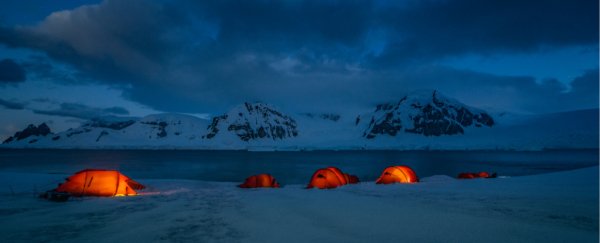Away from the glare of civilisation's blinding lights, an unimpeded view of the night sky makes you feel like you're standing on the shores of eternity. But there is one place on Earth where the sights stretch just that little bit further than anywhere else.
Researchers have measured the clarity of the stars at a major research station in Antarctica, finding it exceeds current top spots for astronomy. The result might not be surprising, but for most of us, it is a little disappointing.
Dome A is the highest ice dome on Antarctica's Polar Plateau. Rising more than 4 kilometres (more than 13,000 feet) from sea level, and sitting roughly 1,200 kilometres (750 miles) from the ocean in the middle of the coldest continent, it's bound to get chilly.
In fact, temperatures can sink as low as -90 Celsius (-130 Fahrenheit).
If that doesn't put you off, though, the rewards might just be worth your effort.
This frozen peak provides an astronomical perspective like no other, with a view relatively unblemished by the stains of light pollution, interference from numerous passing satellites, or even the occasional passing cloud.
"A telescope located at Dome A could out-perform a similar telescope located at any other astronomical site on the planet," says Paul Hickson, an astronomer from the University of British Columbia (UBC).
"The combination of high altitude, low temperature, long periods of continuous darkness, and an exceptionally stable atmosphere, makes Dome A a very attractive location for optical and infrared astronomy. A telescope located there would have sharper images and could detect fainter objects."
If you truly want to see further into the depths of space and time, you'd need to escape the nearest part of the atmosphere called the boundary layer. The gases making up this thin blanket aren't just clogged with dust and moisture – the ground's warmth makes it shimmer, which is why stars seem to twinkle.
One way of quantifying this troublesome twinkling is through a figure called astronomical seeing, which is a description of a light source's apparent diameter in units called arc seconds.
This number signifies the difference of distinguishing a point of light as one source or multiple, so the less turbulence and clearer the vision, the smaller the object (and therefore the shorter the arc second).
Right now, the best ground-based telescopes available to astronomers are at elevations where the boundary layer is relatively thin.
Chile's lofty Atacama Desert is currently regarded as one of the top spot for telescopes, home to the Atacama Large Millimeter Array for radio imaging, and soon to host the insanely huge Giant Magellan Telescope, a beast set to outperform Hubble.
In this corner of the globe, atmosphere conditions can provide astronomical seeing regular figures as low as around 0.66 arc seconds. On some clear nights, that number might even drop by around half for a few hours here and there.
Hickson and his colleagues measured the astronomical seeing at Dome A's Kunlun Station, a Chinese research outpost already regarded as an appealing site for astronomers.
Another chilly inland Antarctic site called Dome C already had estimated values of 0.23 to 0.36 arc seconds. But nobody had a good measure yet on those from Dome A.
Setting their measuring equipment at 8 metres from the ground, the team recorded numbers as low as 0.13 arc seconds, which puts it in the ballpark of observatories outside of the atmosphere. In fact, the number reflects a boundary layer just 14 metres thick.
"After a decade of indirect evidence and theoretical reasoning, we finally have direct observational proof of the extraordinarily good conditions at Dome A," says astronomer Michael Ashley from the University of New South Wales in Australia.
Before you pack your woollies and your trusty old telescope for a night of star gazing, you should know the conditions on Dome A don't just threaten frostbite. Your equipment would need to be state of the art.
"Our telescope observed the sky fully automatically at an unmanned station in Antarctica for seven months, with air temperature dropping to -75 Celsius at times. In and of itself, that's a technological breakthrough," says the study's lead author, UBC astronomer Bin Ma.
Even with advanced technology that could be operated from somewhere warmer, the team had to deal with the ice's scourge. Overcoming the hurdle of extreme temperatures could help see further still, by as much as around 12 percent.
While most of reading this won't ever view the clear sky gazing conditions of Dome A, we may all benefit from the universal insights of large astronomy projects that set up there in the future.
This research was published in Nature.
